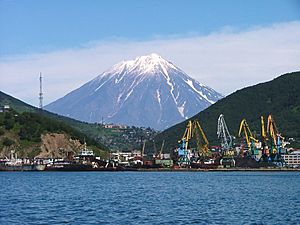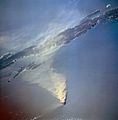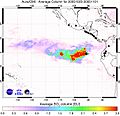Volcano facts for kids

A volcano is like a special mountain with an opening that lets out hot, melted rock called lava. This lava comes from a deep pool of hot rock, called a magma chamber, under the ground. Some volcanoes are active now, while others erupted a long time ago. Volcanoes usually form because of how the Earth's giant tectonic plates move.
Our Earth's outer layer, called the crust, is made of 17 large, stiff tectonic plates. These plates float on a warmer, softer layer inside the Earth called the mantle. You often find volcanoes where these plates are pulling apart or crashing together. Volcanoes can also form where the Earth's crust is stretching and getting thinner, like in the East African Rift. However, they usually don't appear where two plates just slide past each other.
Sometimes, volcanoes form far away from plate edges. This happens because of something called a mantle plume. These "hotspots," like the ones under Hawaii, are thought to be caused by super-hot rock rising from deep inside the Earth, about 3,000 kilometers down near the core–mantle boundary.
Most volcanoes have a bowl-shaped opening at the top called a volcanic crater. When a volcano is active, it releases different materials. These include lava, steam, gassy sulfur compounds, ash, and pieces of broken rock.
When enough pressure builds up inside, the volcano erupts! Some volcanic eruptions are so powerful they can blow off the top of the mountain. Sometimes, the magma rushes out quickly, and other times it flows out slowly. Some eruptions even happen from the side of the volcano instead of the top.
Volcanoes aren't just on Earth! For example, Olympus Mons is a huge volcano on Mars.
Scientists who study volcanoes are called volcanologists. They use ideas from geology, chemistry, geography, physics, and even sociology to understand these amazing natural wonders.
The biggest volcano on Earth is named Mauna Loa in Hawaii. It's one of five volcanoes on Hawaii's 'Big Island'. Mauna Loa last erupted in 1984 and has erupted 33 times in the last 170 years. Like other Hawaiian volcanoes, Mauna Loa was formed as the Pacific tectonic plate moved over a hotspot in the Earth's mantle. Mauna Loa is 4,196 meters tall and is a shield volcano. Its largest recent eruption left a lava trail 51 km long!
Contents
Different Kinds of Volcanoes
The lava and other materials like ash, lava bits, and vapor that come out of volcanoes can create many different land shapes. There are two main types of volcanoes.
Shield Volcanoes: Gentle Giants
These volcanoes are built from very runny, low-silica lava.
Shield volcanoes are made up of many layers of lava from eruptions that happen without big explosions. Because the lava is so runny, it spreads out far and wide. Shield volcanoes don't grow very tall, and their layers of lava create gently sloping sides. These volcanoes can form huge areas of basalt, which is what cooled lava usually becomes.
With each eruption, the base of the volcano gets bigger as the hardened lava spreads out and builds up. Some of the world's largest volcanoes are shield volcanoes.
Even though their sides aren't very steep, shield volcanoes can be enormous. Mauna Kea in Hawaii is actually the tallest mountain on Earth if you measure it from its base on the ocean floor!
Stratovolcanoes: Tall and Steep

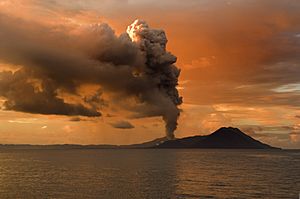
A stratovolcano, also known as a composite volcano, is a tall, cone-shaped volcano. It's built from many layers of hardened lava, tephra (rock fragments), pumice, and volcanic ash.
Unlike shield volcanoes, stratovolcanoes have steep sides and erupt in bursts. The lava from stratovolcanoes is thick and sticky, so it cools and hardens quickly before it can spread far. This magma often has high levels of silica. Large flows of this thick lava are rare, but they have been known to travel as far as 15 km.
Two famous stratovolcanoes are Japan's Mount Fuji and Vesuvius. Both have wide bases and sides that get steeper as you go towards the top. Vesuvius is famous for destroying the towns of Pompeii and Herculaneum in 79 AD, killing thousands of people.
What is a Caldera?
A caldera is a large, basin-like hole that forms when the land collapses after a huge volcanic eruption. This happens when a giant stratovolcano blows its top off. The ground where the crater was then sinks down, leaving a caldera where the top of the volcano used to be. Krakatoa, known for its massive eruption in 1883, is much smaller now because of a caldera.
How Volcanoes Are Made
Volcanoes are formed in two main ways.
One way is when two tectonic plates move towards each other. When they meet, one plate (usually the ocean plate) slides underneath the other (often a continental plate). This process is called subduction. As the plate goes deeper, it melts and creates magma inside a magma chamber. The pressure builds up until the magma bursts through the Earth's crust, forming a volcano.
The second way is when a tectonic plate moves over a super-hot area in the Earth's crust called a hot spot. The hot spot melts its way through the crust until it breaks through. The caldera of Yellowstone Park was formed this way, and so were the Hawaiian Islands.
Are Volcanoes Active, Dormant, or Extinct?
Volcanoes are often grouped by how often they erupt. Volcanoes that might erupt again at any time are called active. Those that are currently quiet but could erupt in the future are called dormant (inactive). Volcanoes that haven't erupted in recorded history are called extinct.
Active Volcanoes: Still Roaring
An active volcano is one that is currently erupting, or has erupted in the last 10,000 years. An example of an active volcano is Mount St. Helens in the United States (US).
Dormant Volcanoes: Sleeping Giants
A dormant volcano is "sleeping." It's not erupting now, but it could wake up and erupt again in the future. Mount Rainier in the United States is considered a dormant volcano.
Extinct Volcanoes: Long Gone
An extinct volcano has not erupted in the past 10,000 years. Edinburgh Castle in Scotland sits on top of an extinct volcano.
Famous Volcanoes Around the World
- Kilauea (Hawaii, USA)
- Krakatoa (Rakata, Indonesia)
- Mauna Loa (Hawaii, USA)
- Mauna Kea (Hawaii, USA)
- Mount Ashitaka (Japan)
- Mount Baker (Washington, USA)
- Mount Edziza (British Columbia, Canada)
- Mount Etna (Sicily, Italy)
- Mount Erebus (Ross Island, Antarctica)
- Mount Hood (Oregon, USA)
- Mount Fuji (Honshu, Japan)
- Mount Rainier (Washington, USA)
- Mount Ruapehu (North Island, New Zealand)
- Mount Shasta (California, USA)
- Mount St. Helens (Washington, USA)
- Novarupta (Alaska, USA)
- Olympus Mons (Mars (planet))
- Popocatépetl (Mexico-Puebla state line, Mexico)
- Surtsey (Surtsey island, Iceland)
- Santorini (Santorini island, Greece)
- Tambora (Sumbawa, Indonesia)
- Teide (Tenerife, Canary Islands, Spain)
- Vesuvius (Gulf of Naples, Italy)
- Yellowstone Caldera (Wyoming, USA)
The Biggest Volcano on Earth
The Earth's largest volcano was found 2 kilometers below the sea on an underwater plateau called the Shatsky Rise. This is about 1,600 kilometers east of Japan. The previous record holder, Mauna Loa in Hawaii, is still the largest volcano on land.
This huge volcano, named Tamu Massif, covers about 310,000 square kilometers. That's similar in size to Mars' enormous Olympus Mons volcano, which is the biggest known volcano in our Solar System. Tamu Massif formed about 145 million years ago when massive lava flows erupted from its center, creating a wide, shield-like shape. This suggests the volcano produced a huge flood basalt eruption.
The Tamu Massif goes about 30 kilometers (18 miles) deep into the Earth's crust. Scientists don't think this underwater volcano's peak ever rose above sea level. They also believe it's very unlikely to erupt again. William Sager, a co-author of the study from the University of Houston, told the AFP news agency: "The bottom line is that we think that Tamu Massif was built in a short (geologically speaking) time of one to several million years and it has been extinct since." He added: "There were lots of oceanic plateaus (that) erupted during the Cretaceous period (145-65 million years ago) but we don't see them since. Scientists would like to know why... The biggest oceanic plateau is Ontong Java Plateau, near the equator in the Pacific, east of the Solomon Islands. It is much bigger than Tamu – it's the size of France."
Volcano Hazards

Volcanic eruptions can be dangerous for people.
Gases from volcanoes can reach high into the atmosphere. There, they form tiny particles of sulfuric acid that can reflect sunlight and make temperatures on Earth's surface drop a lot. For example, sulfur dioxide from the eruption of Huaynaputina might have caused a severe Russian famine of 1601–1603. These particles can also harm the ozone layer. Acids like hydrogen chloride (HCl) and hydrogen fluoride (HF) can fall to the ground as acid rain.
Ash shot into the air by eruptions can be dangerous for airplanes. Especially for jet aircraft, the ash particles can melt from the high heat of the engines. These melted particles then stick to the turbine blades, changing their shape and messing up how the engine works. This can cause big problems for air travel.
A "volcanic winter" is thought to have happened about 70,000 years ago. This was after a huge "supereruption" of Lake Toba in Indonesia. This event might have caused a "population bottleneck" that affected the genes of all humans alive today. Volcanic eruptions might have also played a part in major extinction events, like those at the end of the Ordovician, Permian-Triassic, and Late Devonian periods.
The 1815 eruption of Mount Tambora caused strange weather around the world. This time became known as the "Year Without a Summer" because of its effect on weather in North America and Europe. A very cold winter in 1740–41, which led to widespread famine in northern Europe, might also have been caused by a volcanic eruption.
Volcano Benefits
Even though volcanic eruptions can be dangerous, past volcanic activity has created important resources. Tuff, a soft rock made from volcanic ash, has been used for building since ancient times. The Romans often used tuff, which is common in Italy, for their buildings. The Rapa Nui people used tuff to make most of the moai statues on Easter Island.
Volcanic ash and weathered basalt (cooled lava) create some of the most fertile soil in the world. This soil is rich in important nutrients like iron, magnesium, potassium, calcium, and phosphorus. Volcanic activity also helps create valuable mineral resources, such as metal ores. It also brings a lot of heat from inside the Earth to the surface. This heat can be used to create geothermal power.
Visiting volcanoes is also a popular activity, and volcano tourism is a big industry worldwide.
Staying Safe Near Volcanoes
Many volcanoes near towns and cities are watched very closely. The goal is to give people enough warning before an eruption happens.
Because of this monitoring, even though volcanic eruptions can still cause a lot of damage to property, the number of people who lose their lives has gone down a lot. This is especially true in areas where volcanoes are well-monitored.
This ability to save lives comes from volcano monitoring programs. It also comes from local officials being better at helping people evacuate quickly. Plus, better communication tools like cell phones help spread warnings fast.
If you live near a volcano and are worried about the risks, you should learn about how your local government monitors volcanoes and how they warn people.
Related Pages
- List of volcanoes
- Volcanic eruption
- List of largest volcanic eruptions
- 2019 Whakaari/White Island eruption
- Volcanic hazards
- Prediction of volcanic activity
Images for kids
-
Cleveland Volcano in the Aleutian Islands of Alaska photographed from the International Space Station, May 2006
-
A 2007 eruptive column at Mount Etna producing volcanic ash, pumice and lava bombs
-
Aerial view of the Barren Island, Andaman Islands, India, during an eruption in 1995. It is the only active volcano in South Asia.
-
Santa Ana Volcano, El Salvador. A close-up aerial view of the nested summit calderas and craters, along with the crater lake.
-
Lakagigar fissure vent in Iceland, source of the major world climate alteration of 1783–84
-
Skjaldbreiður, a shield volcano whose name means "broad shield"
-
Izalco (volcano), located in the Cordillera de Apaneca volcanic range complex in El Salvador. Only a few generations old, Izalco is the youngest and best known cone volcano. Izalco erupted almost continuously from 1770 (when it formed) to 1958, earning it the nickname of "Lighthouse of the Pacific".
-
Pāhoehoe lava flow on Hawaii. The picture shows overflows of a main lava channel.
-
San Miguel (volcano), El Salvador. On December 29, 2013, San Miguel volcano, also known as "Chaparrastique", erupted at 10:30 local time, spewing a large column of ash and smoke into the sky; the eruption, the first in 11 years, was seen from space and prompted the evacuation of thousands of people living in a 3 km radius around the volcano.
-
Ash plume from San Miguel (volcano) "Chaparrastique", seen from a satellite, as it heads towards the Pacific Ocean from the El Salvador Central America coast, December 29, 2013
-
Fresco with Mount Vesuvius behind Bacchus and Agathodaemon, as seen in Pompeii's House of the Centenary
-
Fourpeaked volcano, Alaska, in September 2006 after being thought extinct for over 10,000 years
-
Koryaksky volcano towering over Petropavlovsk-Kamchatsky on Kamchatka Peninsula, Far Eastern Russia
-
Sulfur dioxide concentration over the Sierra Negra Volcano, Galapagos Islands, during an eruption in October 2005
-
Olympus Mons (Latin, "Mount Olympus"), located on the planet Mars, is the tallest known mountain in the Solar System.
-
Lava flows at Holuhraun, Iceland, September 2014
-
Ash plume rising from Eyjafjallajökull on April 17, 2010
See also
 In Spanish: Volcán para niños
In Spanish: Volcán para niños


